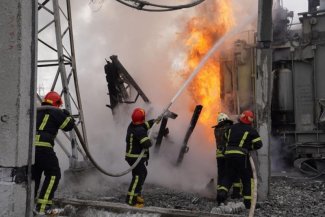Fighting in the Donbas intensifies. Day 354 of the war

Ukrainian forces have brought new units into action on the battlefields near Kreminna and Vuhledar; as a result they have been able to halt the enemy’s advance and partially push them back to the positions the Russians previously held. However, on most sections of the line of contact where fighting is taking place, Russian pressure is forcing the defenders to gradually withdraw. The invaders’ units are advancing deep into the enemy’s positions at a rate of several hundred metres, and occasionally up to several kilometres per day. Their advance in the north-eastern part of Kharkiv oblast should bring them to the Oskil river crossing at the Dvorichna rise (north of Kupiansk). According to the Ukrainians, clashes are still ongoing in the neighbouring town of Hrianykivka across the river.
The main area of fighting remains the region around Bakhmut, where the heaviest battles are still being fought for control of the most important routes to the west (toward Kostiantynivka and on to Kramatorsk) and northwest (the M03 main road running toward Sloviansk). It is reported that the Russians were unsuccessfully renewing their assaults in the area of the town of Chasiv Yar, where they are trying to cut off the Ukrainians’ last supply route of Bakhmut. According to the local command, a record 54 clashes took place there on 10 February, with enemy artillery shelling the defenders’ positions 124 times. 11 February also saw the highest number of Russian strikes (424) on the section of the front between Kreminna and Lyman. Particularly heavy clashes are continuing on the approaches to the Zherebets River near Torske (12 km east of Lyman). The invaders have also resumed their assault in the area of Huliaipole in the Zaporizhzhia oblast, but were stopped west of the town.
On 10 February, the Russians launched another missile attack (the fourteenth, according to the Ukrainian national grid operator Ukrenerho) on Ukraine’s energy infrastructure, using kamikaze drones and artillery. Hydroelectric plants, thermal power plants and high-voltage substations and power lines in six regions in the east, south and west of the country were hit. The worst damage was reported in the Kharkiv, Khmelnytskyi, Dnipropetrovsk and Zaporizhzhia oblasts. In their summary of the attack, the General Staff reported that the enemy used a total of 106 missiles, including 74 cruise missiles (of which the defenders were said to have shot down 61), and 28 Shahed-136 drones, 22 of which were neutralised. The Ukrainian army reported that one Russian missile violated Romanian airspace, but the Romanian defence ministry did not confirm the report.
The Russians continued to launch rocket attacks on the Ukrainian forces’ logistical facilities in the north-western part of Donetsk oblast, and on industrial facilities in Kharkiv. In addition, on 11 February they carried out a rocket strike (using Oniks missiles fired from Crimea) on the coastal area of Odesa. The positions and facilities of Ukrainian forces along the line of contact and in border areas are also under constant attack from Russian artillery and aviation. The invaders are also still shelling Kherson and the surrounding towns, Nikopol oblast and the coastal part of Mykolayiv oblast around ten times a day. Snake Island also came under fire for the first time in more than six months. Ukrainian artillery hit the rear of the enemy forces in Melitopol and the area around Mariupol, and another act of sabotage took place in Russia’s Belgorod oblast.
The Lithuanian defence ministry said that the first batch of 40-mm Bofors L/70 automatic anti-aircraft cannons had arrived in Ukraine, and announced it was transferring 36 anti-aircraft gun/missile systems (the type was not indicated) to combat drones. The Indian press reported that in early February Pakistan had sent 10,000 122-mm unguided rockets to Ukraine for use with Grad multiple rocket launchers. The head of the Dutch defence ministry announced that Berlin had refused to provide Kyiv with 18 Leopard-2A6 tanks which its army had leased. Switzerland, in turn, apparently refused to allow Spain to transfer two of its 35-mm anti-aircraft guns to Ukraine.
In mid-February, Germany is to begin the accelerated training of Ukrainian tank crews. The six to eight-week course will give them the basic skills to operate Leopard-2A6 tanks and ensure their interaction with Marder infantry fighting vehicles. According to the plan, the first Ukrainian Leopards are scheduled to reach the front at the end of March. A group of servicemen who had been serving there has now arrived in Belgium, where they will learn how to use underwater reconnaissance drones as part of a European Union training mission (EUMAM Ukraine).
On 9 February, President Volodymyr Zelensky visited Brussels after having earlier held talks with the British prime minister in London and the French president and German chancellor in Paris. In a speech at the European Parliament, Zelensky renewed his call to speed up deliveries of weapons, specifically long-range artillery systems, ammunition, tanks and fighters. He also formally asked Slovakia to hand over post-Soviet MiG-29 fighter jets to Kyiv. Representatives of the country’s government confirmed that dialogue on the issue has begun, but stressed that the Slovak army has been using the Migs for a long time and does not have any spare parts for them. Bratislava also announced that talks had started on the issue within the EU, as had negotiations with the EC on covering the costs of Slovakia’s military support for Ukraine. The Dutch defence minister also reported that Kyiv had made an official inquiry about the possibility of receiving F-16 aircraft from the Netherlands. On his way home Zelensky met the Polish president in Rzeszów. They discussed security issues in the region, and stressed the need for further joint efforts to support the Ukrainian army militarily.
Ukraine’s state-owned arms concern Ukroboronprom has announced that it has begun the production of 120-mm mortar rounds in collaboration with a NATO country; the arms cooperation agreements revealed in recent weeks suggest that the Czech Republic is the partner in question. The Ukrainian defence industry is also cooperating with its counterparts in Poland and Slovakia.
Oleksiy Danilov, the secretary of the National Security and Defence Council, assessed on 11 February that Russian forces are having problems in launching a major offensive. Commenting on a statement by the Russian deputy foreign minister Sergei Vershinin, who said that Moscow is allegedly ready to negotiate with Kyiv “without preconditions,” Danilov stated that the invaders are trying to implement the ‘Second Ukraine’ project. This envisages the dissemination of the idea of a so-called ‘Korean solution’, involving the establishment of a new line of demarcation that would allow Russia to keep the territories it has annexed. On the same day, Ukrainian military intelligence (HUR) confirmed that the enemy intends to intensify its military efforts in eastern Ukraine over the coming weeks, although this does not mean large-scale offensive operations. HUR also stated that the enemy is preparing for a second wave of mobilisation, but that it will be delayed due to a lack of officers and sufficient quantities of modern equipment, as well as the protracted process of training the conscripted troops. Also on 11 February, Ukraine’s defence minister Oleksiy Reznikov stated that Russian forces have lost their dominance of the Black Sea; as he put it, a landing in the Odesa area is not possible at the moment, and the city is being defended by Harpoon anti-ship missiles, among other facilities.
According to British military intelligence Yevgeny Prigozhin, the head of the so-called Wagner Group, has stopped recruiting mercenaries from prisons, under pressure from the Russian defence ministry. One of the reasons for this was his attribution of successes at the front to Wagner. It is also reported that the recruitment is being hampered by reports of the horrific nature of the fighting in Ukraine. British intelligence has also pointed out that despite the concentration of forces in the Donbas, the Russians also need to maintain their defences in Zaporizhzhia oblast. The invaders are said to be reinforcing their fortifications in the central part of the oblast out of concern that a potential breakthrough by Ukrainian forces would call into question the security of the ‘land bridge’ connecting the Rostov region with Crimea.
Speculation about the future fate of Ukraine’s defence minister has not calmed down. On 11 February Maryana Bezuhla of the Servant of the People party confirmed that draft legislative changes to appoint an active military officer to the post have been prepared. This signals that the idea of appointing the current head of military intelligence Kyrylo Budanov to the post is still being considered. As of 2018, according to current legislation, the defence minister can only be a civilian.
An anti-corruption operation is underway in Ukraine. On 10 February, the State Bureau of Investigation and the Security Service of Ukraine searched premises used by the State Customs Service in Kyiv, Lviv, Ternopil, Chernivtsi and Odesa. According to preliminary data, the extent of the corruption itself was causing losses of 10 billion hryvnias (about $280 million) a month to the state budget. Meanwhile, on 11 February President Zelensky dismissed Ruslan Dziuba from his post as deputy commander of the National Guard in charge of the logistics division. No reasons were given for the move, but it may be related to the corruption scandals concerning military procurement which have recently been uncovered.
Commentary
- In line with their announcements, the government in Kyiv have no plans to surrender Bakhmut, and the Ukrainian army is taking extensive measures to hold the defence line in the Donbas. However, the reinforcements directed so far to the combat areas have allowed only a local stabilisation of the front line, while the clashes between Kreminna and Lyman indicate that it may be short-lived. However, the combatants’ positions in the Vuhledar area have become relatively stable; after their initial successes, the Russians have proved unable to break the defence line on the southern and eastern outskirts of the town, and Ukrainian forces have now repaired the breach west of it toward Bohoyavlenka. In the Bakhmut area, the Ukrainians have failed to stop the enemy: their stubborn defence is only slowing the Russians down. It remains unclear how the situation in the north-eastern part of Kharkiv oblast is developing: here the invaders have made advances north of Kupiansk. If they can cross over in the Dvorichna area, that would open up the option of moving the fighting to the western bank of the Oskil river and further into Kharkiv oblast without having to launch strikes from Russian territory.





